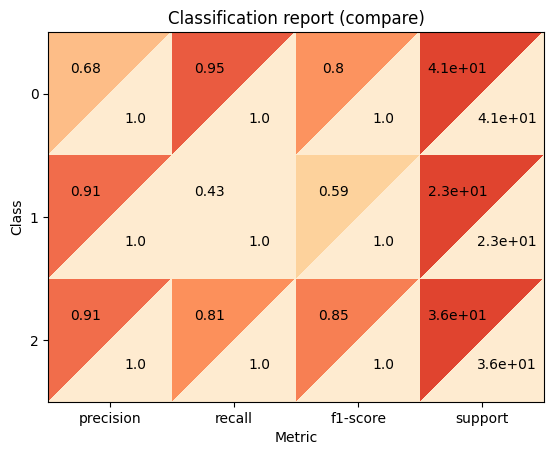Classification
Contents
Classification#
In this guide we’ll show how to compare and evaluate models with sklearn-evaluation. We will use the penguins dataset and will try to classify based on parameters such as bill and flipper size, and which penguin species is it.
The steps in this guide are:
Loading the dataset
Data cleaning
Fitting models
Evaluating the features and models
Comparing the different models
In steps 4 & 5 the real value of sklearn-evaluation comes to fruition as we get a lot of visualizations out of the box which will help us compare and evaluate the models, making it easier to pick the optimal one.
import pandas as pd
import seaborn as sns
from sklearn.preprocessing import LabelEncoder
from sklearn.model_selection import train_test_split
from sklearn import tree
from sklearn.neighbors import KNeighborsClassifier
from sklearn.metrics import accuracy_score, classification_report
from sklearn_evaluation import plot, table
# Based on
# https://github.com/Adeyinka-hub/Machine-Learning-2/blob/master/Penguin%20Dataset.ipynb
Load the dataset#
df = sns.load_dataset("penguins")
# Review a sample of the data
df.head(5)
| species | island | bill_length_mm | bill_depth_mm | flipper_length_mm | body_mass_g | sex | |
|---|---|---|---|---|---|---|---|
| 0 | Adelie | Torgersen | 39.1 | 18.7 | 181.0 | 3750.0 | Male |
| 1 | Adelie | Torgersen | 39.5 | 17.4 | 186.0 | 3800.0 | Female |
| 2 | Adelie | Torgersen | 40.3 | 18.0 | 195.0 | 3250.0 | Female |
| 3 | Adelie | Torgersen | NaN | NaN | NaN | NaN | NaN |
| 4 | Adelie | Torgersen | 36.7 | 19.3 | 193.0 | 3450.0 | Female |
Data cleaning#
In this section, we’re cleaning and preparing the dataset for fitting. It’s all in a single cell since this isn’t too relevant to the tool itself.
df.isnull().sum()
df.dropna(inplace=True)
Y = df.species
Y = Y.map({"Adelie": 0, "Chinstrap": 1, "Gentoo": 2})
df.drop("species", inplace=True, axis=1)
se = pd.get_dummies(df["sex"], drop_first=True)
df = pd.concat([df, se], axis=1)
df.drop("sex", axis=1, inplace=True)
le = LabelEncoder()
df["island"] = le.fit_transform(df["island"])
Decision Tree Classifier#
X = df
X_train, X_test, y_train, y_test = train_test_split(
X, Y, test_size=0.3, random_state=40
)
dtc = tree.DecisionTreeClassifier()
dt_model = dtc.fit(X_train, y_train)
y_pred_dt = dt_model.predict(X_test)
print("Acc on test data: {:,.3f}".format(dtc.score(X_test, y_test)))
Acc on test data: 1.000
y_test
{"Adelie": 0, "Chinstrap": 1, "Gentoo": 2}
{'Adelie': 0, 'Chinstrap': 1, 'Gentoo': 2}
Evaluate our model#
In this section, we can easily evaluate our model via a confusion matrix, and understand which feature affects our accuracy by order of importance.
plot.confusion_matrix(y_test, y_pred_dt)
<Axes: title={'center': 'Confusion matrix'}, xlabel='Predicted label', ylabel='True label'>
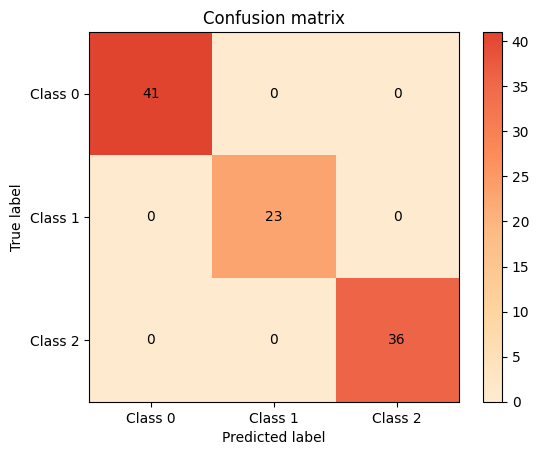
plot.feature_importances(dtc, top_n=5, feature_names=list(dtc.feature_names_in_))
<Axes: title={'center': 'Feature importances'}>
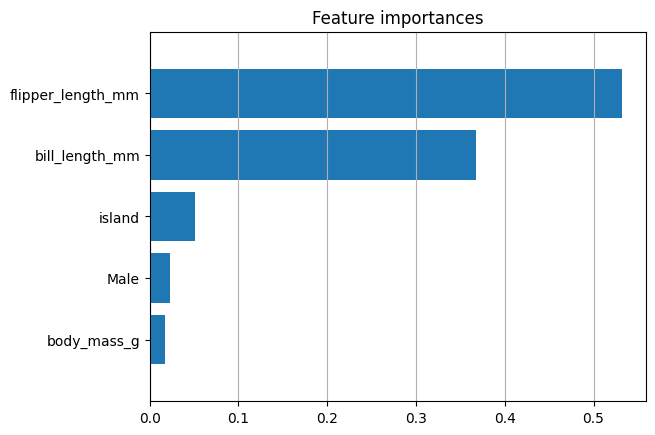
In addition to the plot, we can also represent the importance through a table, which we can later track and query via SQL. For more information, check our tracking guide
print(table.feature_importances(dtc, feature_names=list(dtc.feature_names_in_)))
+-------------------+--------------+
| feature_name | importance |
+===================+==============+
| flipper_length_mm | 0.532197 |
+-------------------+--------------+
| bill_length_mm | 0.367249 |
+-------------------+--------------+
| island | 0.0513876 |
+-------------------+--------------+
| Male | 0.0232564 |
+-------------------+--------------+
| body_mass_g | 0.0175715 |
+-------------------+--------------+
| bill_depth_mm | 0.00833904 |
+-------------------+--------------+
KNN classifier#
KNN = KNeighborsClassifier()
KNN.fit(X_train, y_train)
y_pred_knn = KNN.predict(X_test)
print(accuracy_score(y_test, y_pred_knn))
print(classification_report(y_test, y_pred_knn))
knn_cm = plot.confusion_matrix(y_test, y_pred_knn)
0.78
precision recall f1-score support
0 0.68 0.95 0.80 41
1 0.91 0.43 0.59 23
2 0.91 0.81 0.85 36
accuracy 0.78 100
macro avg 0.83 0.73 0.75 100
weighted avg 0.82 0.78 0.77 100
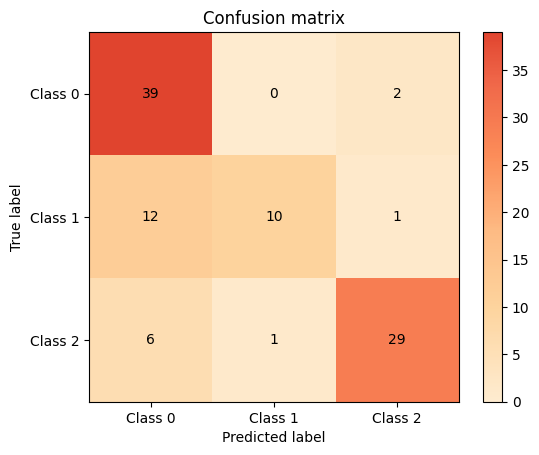
Comparing KNN and Random Forest reports#
In this section, we will overlay both of the models via the confusion matrices. We will do the same with the classification report. This will allow us to pick the superior model without a lot of effort.
knn_cm = plot.ConfusionMatrix.from_raw_data(y_test, y_pred_knn)
dt_cm = plot.ConfusionMatrix.from_raw_data(y_test, y_pred_dt)
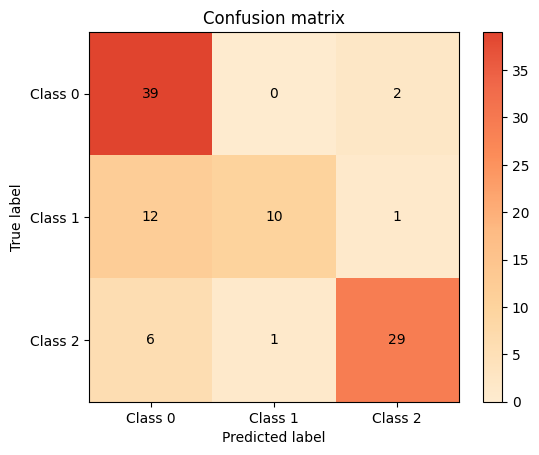
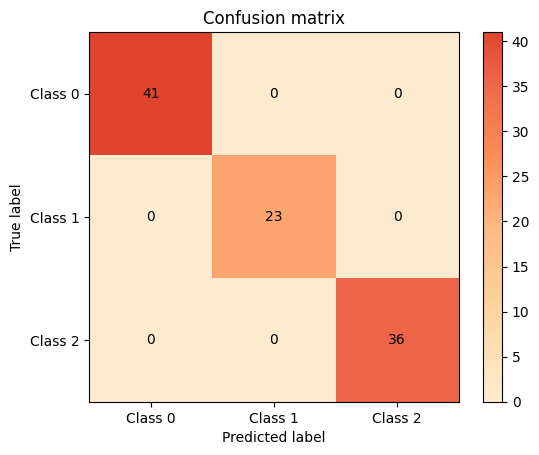
knn_cm + dt_cm
<sklearn_evaluation.plot.classification.ConfusionMatrixAdd at 0x7f8fc5ed6df0>
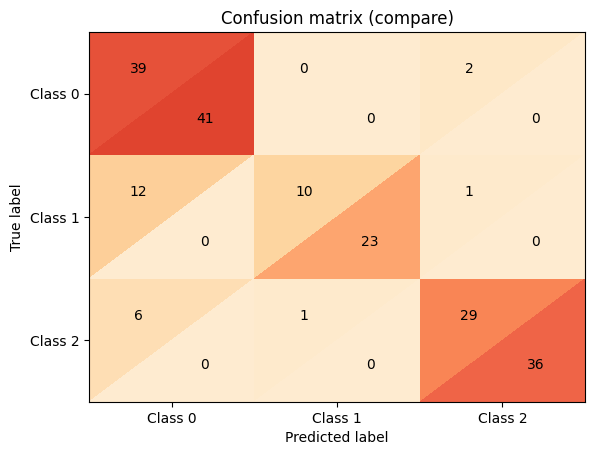
dt_cr = plot.ClassificationReport.from_raw_data(y_test, y_pred_dt)
knn_cr = plot.ClassificationReport.from_raw_data(y_test, y_pred_knn)
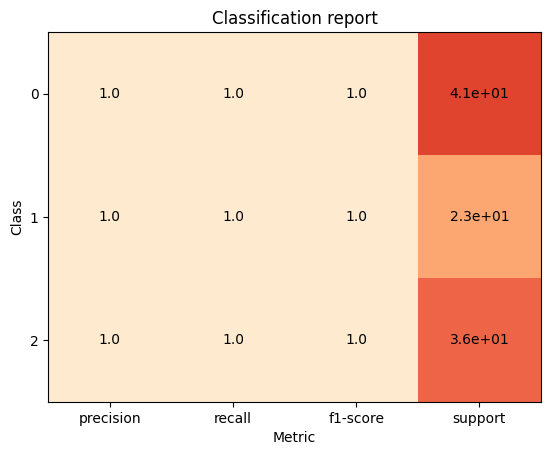
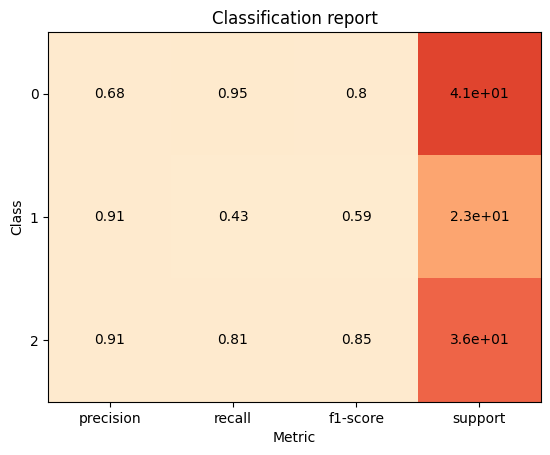
knn_cr + dt_cr
<sklearn_evaluation.plot.classification_report.ClassificationReportAdd at 0x7f8fc53cfee0>
